oil level AUDI Q3 2017 Owner´s Manual
[x] Cancel search | Manufacturer: AUDI, Model Year: 2017, Model line: Q3, Model: AUDI Q3 2017Pages: 236, PDF Size: 58.93 MB
Page 11 of 236
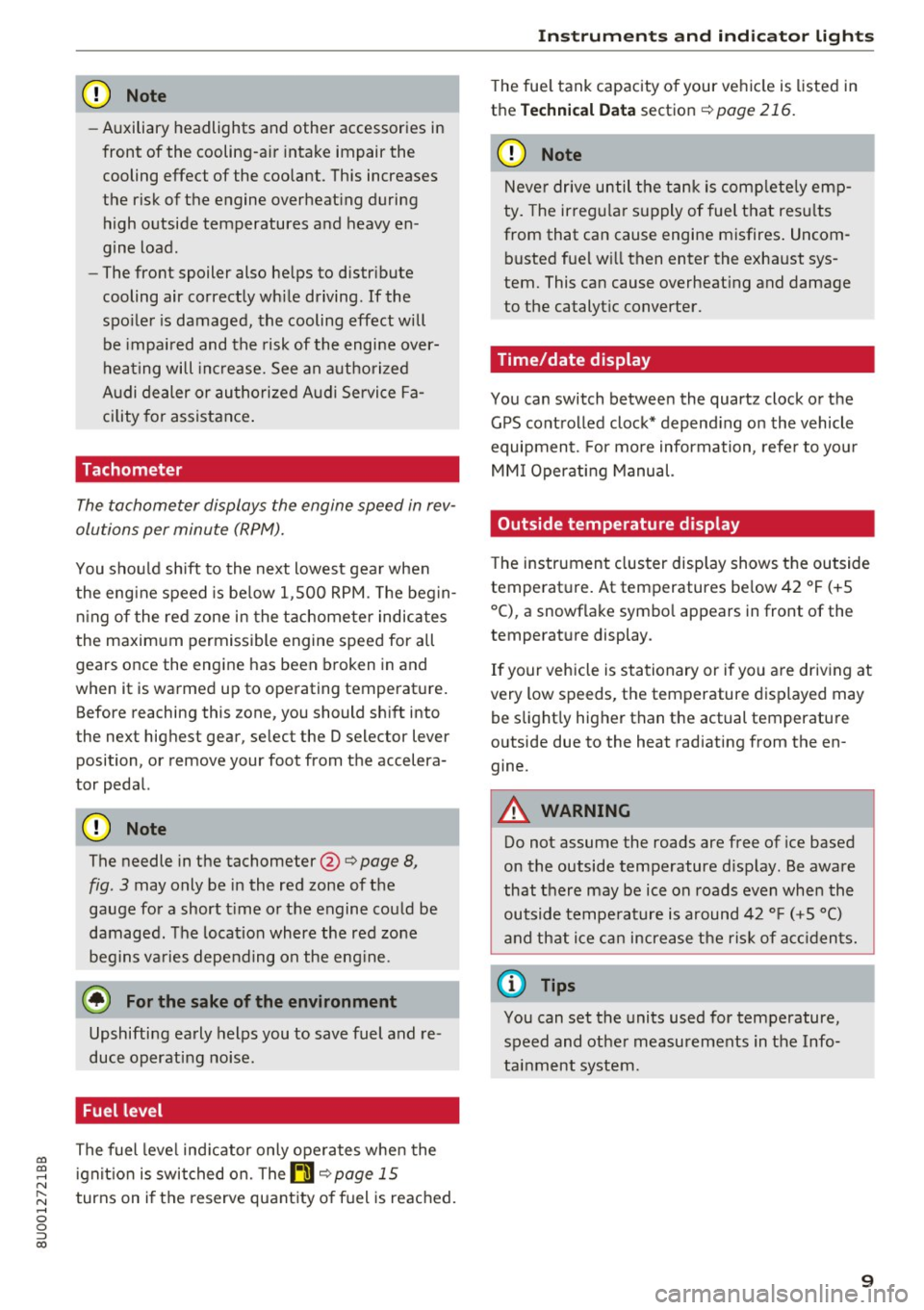
00
00
......
"' ,....
"' ...... 0 0 :::,
00
CD Note
- Auxiliary headlights and other accessories in
front of the cooling-air intake impair the
cooling effect of the coolant. This increases
the risk of the engine overheating during
high outside temperatures and heavy en-
gine load.
- The front spoiler also helps to distribute
cooling air correctly wh ile driving. If the
spo iler is damaged, the cooling effect will
be impai red and the risk of the engine over
heating will increase. See an authorized
A udi dealer or authori zed Aud i Service Fa
cility for assistance .
Tachometer
The tachometer displays the engine speed in rev
olutions per minute
(RPM).
You shou ld shift to the next lowest gear when
the eng ine speed is be low 1,500 RPM. The beg in
ning of the red zone in the tachometer indicates
the maximum permissible engine speed for all
gears once the engine has been broken in and
when it is warmed up to operating temperature.
Before reaching this zone, you should sh ift into
the next highest gear, select the D selector lever position, or remove your foot from the accelera
tor pedal.
CD Note
The needle in the tachometer @
Q page 8,
fig. 3 may only be in the red zone of the
gauge for a short t ime or the engine could be
damaged. The location where the red zone
begins va ries depend ing on the eng ine.
@) For the sake of the environment
Upshifting early helps you to save fuel and re
duce operating noise.
Fuel level
The fuel leve l ind icator only ope rates when the
i gnit io n is switched on. The
tD Qpage 15
turns on if the reserve quant ity of fuel is reac hed.
In strum ents an d ind ic a to r ligh ts
The fue l tank capacity of your vehicle is listed in
the Techni cal Data section
Q page 216.
(D Note
Neve r dr ive until the tank is comp lete ly emp
ty. The irregu la r supply of fuel that res ults
from that can cause engine misfires . Uncom
busted fuel w ill then enter the exhaust sys
tem. This can cause overheat ing and damage
to the catalyt ic converter.
Time/date display
You can switch between the quartz clock or the GPS controlled clock* depend ing on the vehicle
equipment. For mo re information, refe r to you r
MM I Operating Manual.
Outside temperature display
T he instrument cluster display shows the outside
temperature. At temperatures be low 42 °F ( +S
°C), a snowflake symbo l appears in front of the
temperature display.
If your vehicle is stationary or if you a re driving at
very low speeds, the temperature displayed may be slight ly higher than the actual temperature
o utside due to the heat radiating from the en
gine.
A WARNING
.-
Do not assume the roads are free of ice based
on the outside temperature d isplay. Be aware
that there may be ice on roads even when the
outside tempe rature is a round 42 °F (+5 °C)
a nd that i ce can increase t he risk of a cc idents.
(0 Tips
You can set the units used for temperature,
speed and othe r measurements in the Info
tai nment system.
9
Page 15 of 236
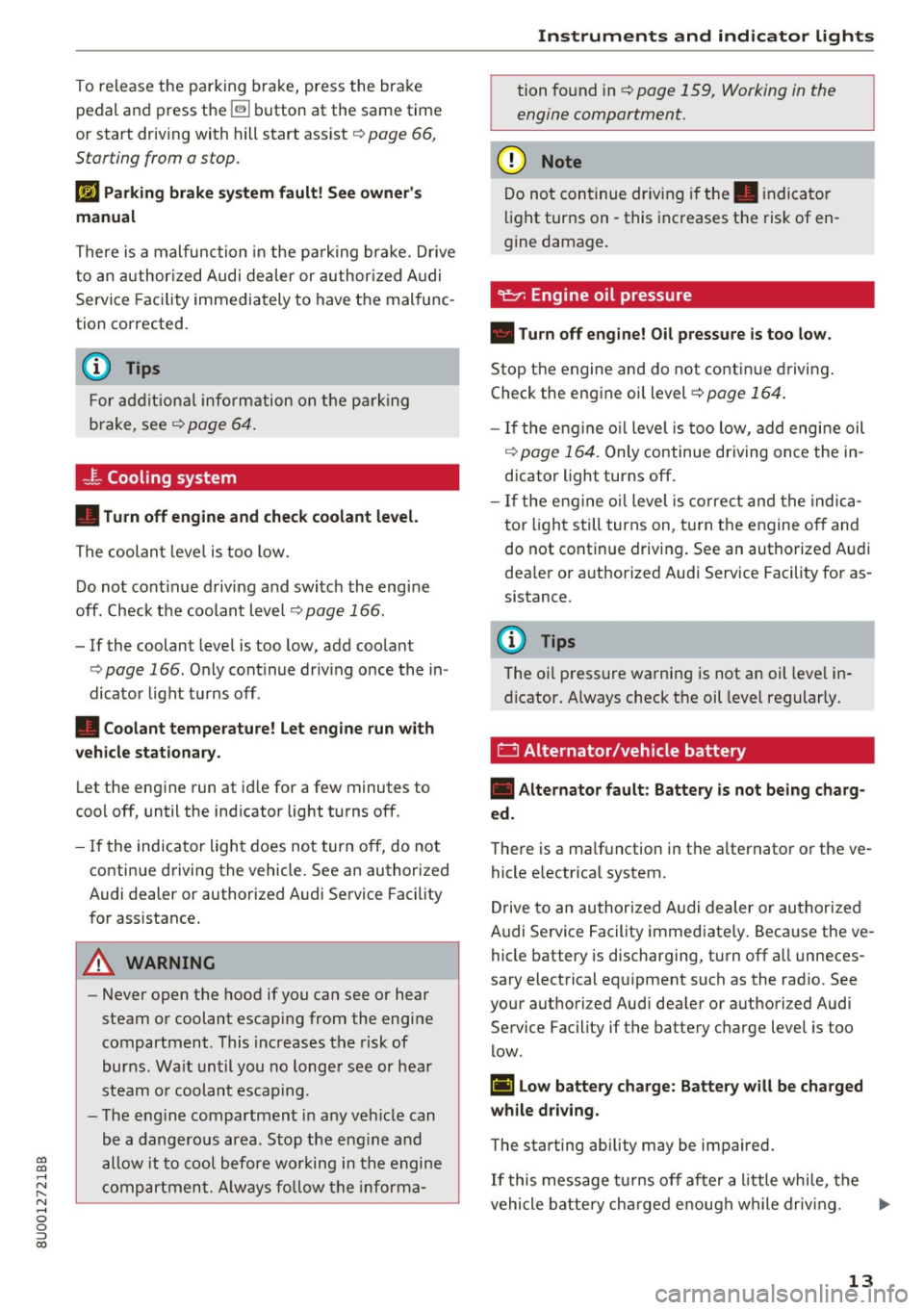
00
00
.....,
"' ,....
"' .....,
0 0 :::,
00
To release the parking brake, press the brake
pedal and press the~ button at the same time
or start driving with hill start assist
¢ page 66,
S tar ting from a s top.
rlJ Parking brake system fault! See owner's
manual
There is a malfunction in the parking brake. Drive
to an authorized Audi dealer or authorized Audi
Service Facility immediately to have the malfunc
tion corrected.
@ Tips
For additional information on the parking
brake, see
¢ page 64.
- ~- Cooling system
• Turn off engine and check coolant level.
The coolant level is too low.
Do not continue driving and switch the engine
off. Check the coolant level¢
page 166.
-If the coolan t level is too low, add coolant
¢page 166. Only continue driving once the in
dicator light turns off.
• Coolant temperature! Let engine run with
vehicle stationary.
Let the engine run at idle for a few minutes to
cool off, until the indicator light turns off.
- If the indicator light does not turn off, do not
continue driving the vehicle. See an authorized
Audi dealer or authorized Audi Service Facility
for assistance.
.&_ WARNING
- Never open the hood if you can see or hear
steam or coolant escaping from the engine compartment . This increases the risk of
burns. Wait until you no longer see or hear
steam or coolant escaping .
- The engine compartment in any vehicle can
be a dangerous area. Stop the engine and
allow it to cool before working in the engine
compartment. Always follow the informa-
-
Instruments and indicator lights
tion found in ¢ page 159, Working in the
engine compartment.
@ Note
Do not continue driving if the . indicator
light turns on -this increases the risk of en
gine damage.
Stop the engine and do not continue driving.
Check the engine oil level
¢ page 164.
- If the engine oil level is too low, add engine oil
c:!;> page 164. Only continue driving once the in
dicator light turns off.
- If the engine oil level is correct and the indica
tor light still turns on, turn the engine off and
do not continue driving. See an authorized Audi
dealer or authorized Audi Service Facility for as
sistance.
(D Tips
The oil pressure warning is not an oil level in
dicator. Always check the oil level regularly .
0 Alternator/vehicle battery
• Alternator fault: Battery is not being charg
ed.
There is a malfunction in the alternator or the ve
hicle electrical system .
Drive to an authorized Audi dealer or authorized
Audi Service Facility immediately. Because the ve
hicle battery is discharging, turn off all unneces
sary electrical equipment such as the radio. See
your authori zed Audi dealer or authori zed Audi
Service Facility if the battery charge level is too
low .
r•j low battery charge: Battery will be charged
while driving.
The starting ability may be impaired.
If this message turns off after a little while, the
vehicle battery charged enough while driving. ..,_
13
Page 17 of 236

00
00
......
"' ,....
"' ...... 0 0 :::,
00
A WARNING , ~ -
Have the malfunction in the safety systems
inspected immediately. Otherwise, there is a
r isk that the systems may not activate during
a collision, which increases the risk of serious
injury or death.
(0) Brake pads
Ei] Brake pad s!
The brake pads are worn .
Drive to an authorized Aud i dea ler or authorized
Audi Service Facility immediately to have the brake pads checked.
App lies to: USA models
The Ei] indicator light turns on together with the
1111 indicator light
EPC Engine control (gasoline engine)
Applies to: vehicl es with gasoline engines
If the 13:a indicator light turns on while driving,
there is an eng ine control malfunction.
Immediately drive slowly to an authorized Audi
dealer or authori zed Audi Service Facility to have
the malfunction corrected.
0 Malfunction indicator lamp (MIL)
The malfunction indicator lamp (MIL) is part of
the On Board Diagnostic system (OBD II). The
¢4 symbol turns on when the ign ition is switched
on and turns off again once the e ngine is started
and running at a steady id le speed . This indicates
that the MIL is functioning correctly.
The indicato r light turns on if there is a malfunc
tion in the engine electronics. See an autho rized
Audi dealer or authorized Audi Service Facility to
have the ma lfunction corrected. For additiona l
information, see
~ page 17.
The indicator light can also turn on if the f uel fill
e r cap is not closed correct ly
i::!> page 157.
Instruments and indicator lights
!"-" , Engine speed lim itation
Applies to: vehicles with engine speed limitation
(I! Maximum engine speed XXXX RPM
The engine speed is automatically limited to the
speed displayed in the driver information system.
This protects the engine from overheat ing .
The engine speed limitation deactivates once the engine is no longer in the critical temperature
range and you have released the accelerator ped
al once .
If the engine speed limitation was activated by
an engine control malfunction, the
13:a in dicator
light also turns on. Make sure that the speed
does not go above the speed displayed . Dr ive to
an authorized Aud i dea le r or authorized Audi
Service Facility immed iately to have the malfunc
tion corrected.
~;. Engine oil
Ill Check oil level.
Refill engine oil as soon as possible i::!>page 162.
~ .,. Engine oil sensor
• Oil level sensor: System fault!
The sensor to check the eng ine o il level has
failed. Drive to an authorized Audi dealer or au
thorized Aud i Serv ice Facility immediately to have
the malfunction cor rected.
i) Tank system
H Please refuel
If the indicator l ight turns on for the first time
and the message appears, there are about
1.8 -2.2 gallons ( 7.0 -8. S liters) of fuel left in the
tank .
H Fuel tank system malfunction! Contact deal
er
Drive to an authorized Audi dealer or authorized
Audi Service Facility immed iately to have the
malfunction corrected. ..,.
15
Page 60 of 236
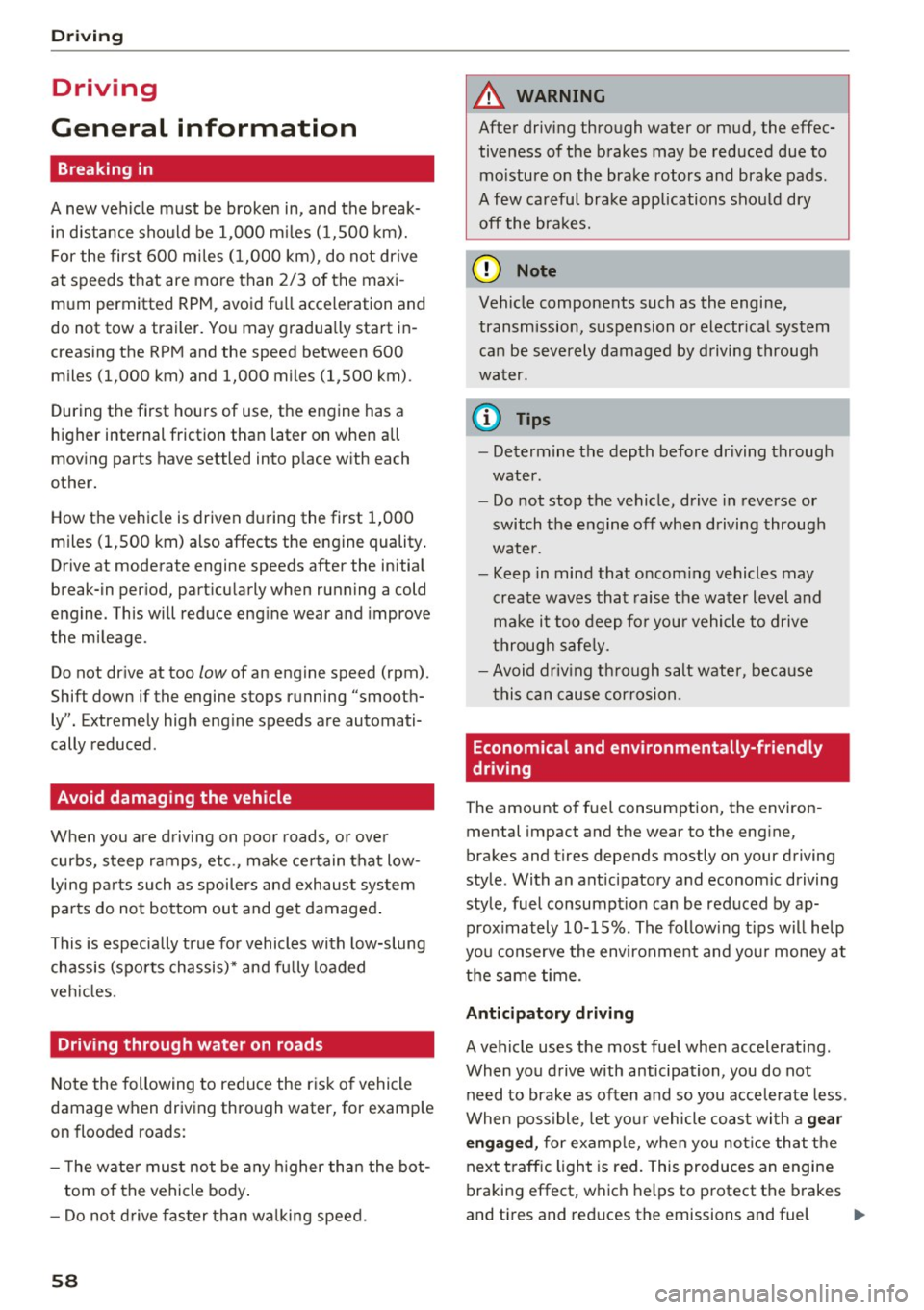
Driving
Driving
General information
Breaking in
A new vehicle must be broken in, and the break in distance should be 1,000 miles (1,500 km).
For the first 600 miles (1,000 km), do not drive
at speeds that are more than 2/3 of the maxi
mum permitted RPM, avoid full acceleration and
do not tow a trailer. You may gradually start in
creasing the RPM and the speed between 600 miles (1,000 km) and 1,000 miles (1,500 km) .
During the first hours of use, the engine has a
higher internal friction than later on when all
moving parts have settled into place with each
other.
How the vehicle is driven during the first 1,000
miles (1,500 km) also affects the engine quality.
Drive at moderate engine speeds after the initial
break-in period, particularly when running a cold
engine . This will reduce engine wear and improve
the mileage .
Do not drive at too
low of an engine speed (rpm).
Shift down if the engine stops running "smooth ly". Extremely high engine speeds are automati
cally reduced .
Avoid damaging the vehicle
When you are driving on poor roads, or over
curbs, steep ramps , etc., make certain that low
lying parts such as spoilers and exhaust system
parts do not bottom out and get damaged.
This is especially true for vehicles with low-slung
chassis (sports chassis)* and fully loaded
vehicles.
Driving through water on roads
Note the following to reduce the risk of vehicle
damage when driving through water, for example
on flooded roads:
- The water must not be any higher than the bot
tom of the vehicle body.
- Do not drive faster than walking speed.
58
A WARNING ,_
After driving through water or mud, the effec
tiveness of the brakes may be reduced due to
moisture on the brake rotors and brake pads.
A few careful brake applications should dry
off the brakes.
([) Note
Vehicle components such as the engine,
transmission, suspension or electrical system
can be severely damaged by driving through
water.
(D Tips
- Determine the depth before driving through
water.
- Do not stop the vehicle, drive in reverse or
switch the engine off when driving through
water.
- Keep in mind that oncoming vehicles may
create waves that raise the water level and
make it too deep for your vehicle to drive
through safely.
-Avoid driving through salt water, because
this can cause corrosion.
Economical and environmentally-friendly
driving
The amount of fuel consumption, the environ
mental impact and the wear to the engine,
brakes and tires depends mostly on your driving
style . With an anticipatory and economic driving
style, fuel consumption can be reduced by ap proximately 10-15%. The following tips will help
you conserve the environment and your money at
the same time.
Anticipatory driving
A vehicle uses the most fuel when accelerating .
When you drive with anticipation, you do not need to brake as often and so you accelerate less.
When possible , let your vehicle coast with a gear
engaged, for example, when you notice that the
next traffic light is red. This produces an engine
braking effect, which helps to protect the brakes
and tires and reduces the emissions and fuel
...
Page 61 of 236

00
00
......
"' ,....
"' ...... 0 0 :::,
00
consumption to zero (fuel shut-off during decel
eration).
Shift efficiently
An effective way to save fuel is to upshift earlier .
Staying in a gear too long uses fuel unnecessari
ly. Press down on the accelerator pedal slowly
and avoid "kick-down".
Avoid full acceleration
You should rarely travel at the maximum vehicle
speed. High speeds cause a disproportionately
high increase in fuel consumption, emissions and
traffic noise. Slower driving saves fuel.
Reduce idling time
There are benefits to stopping the engine, for ex
ample when at railroad crossings or traffic lights
with longer red lights. Stopping the engine for
30-40 seconds already saves more fuel than the
amount of extra fuel needed to restart the en
gine.
It takes a very long time in idle to warm the en
gine up to operating temperature . Wear and
emissions are especially high in the warm-up
phase. Therefore, you should begin driving im
mediately after starting the engine. Avoid high
RPMs while doing this.
Have maintenance performed regularly
By having maintenance performed regularly on
your vehicle, you can help to reduce fuel con
sumption before you even start to drive. The maintenance condition of your vehicle not only
affects traffic safety and long-term value but al
so impacts
fuel consumption. A poorly main
tained engine can lead to fuel consumption that
is 10% higher than normal.
Also check the
oil level when refueling. The oil
consumption
depends largely on the engine load
and speed . It is normal for the oil consumption
of a new engine to reach its lowest point only af
ter a certain amount of use. Therefore, the oil
consumption can only be properly judged after
approximately 3,000 miles (5,000 km) have been
driven.
Driving
Fewer short trips
The engine and catalytic converter have to reach
their optimal
operating temperature to reduce
fuel consumption and noxious emissions effec
tively.
Just after starting, a cold engine in a mid-size car
only achieves a fuel economy of 6-8 mpg
(30-40 l/100 km). After about a half a mile, fuel
economy climbs to 12 mpg (20 l/100 km). After
about 2.5 mi
(4 km), the engine is at its proper
operating temperature and fuel economy has
reached a normal level. So you can see that you
should avoid short trips whenever possible .
The
outside temperature is also critical in this re
gard. Your car consumes more fuel in the winter
than in the summer.
@ Note
Do not leave engine idling unattended after
starting. If warning lights should come on to indicate improper operation, they would go
unheeded. Extended idling also produces
heat, which could result in overheating or
other damage to the vehicle or other proper
ty.
(D Note
- Have your vehicle maintained properly and
in accordance with the service recommenda
tions in your Warranty & Maintenance book
let. Lack of proper maintenance as well as
improper use of the vehicle will impair the
function of the emission control system and could lead to damage.
- Do not alter or remove any component of
the Emission Control System unless ap
proved by the manufacturer.
- Do not alter or remove any device, such as
heat shields, switches, ignition wires,
valves, which are designed to protect your
vehicle's Emission Control System and other
important vehicle components .
(j) Tips
The consumption estimates as published by
ENVIRONMENTAL PROTECTION AGENCY
(EPA) and Transport Canada may not
59
Page 99 of 236
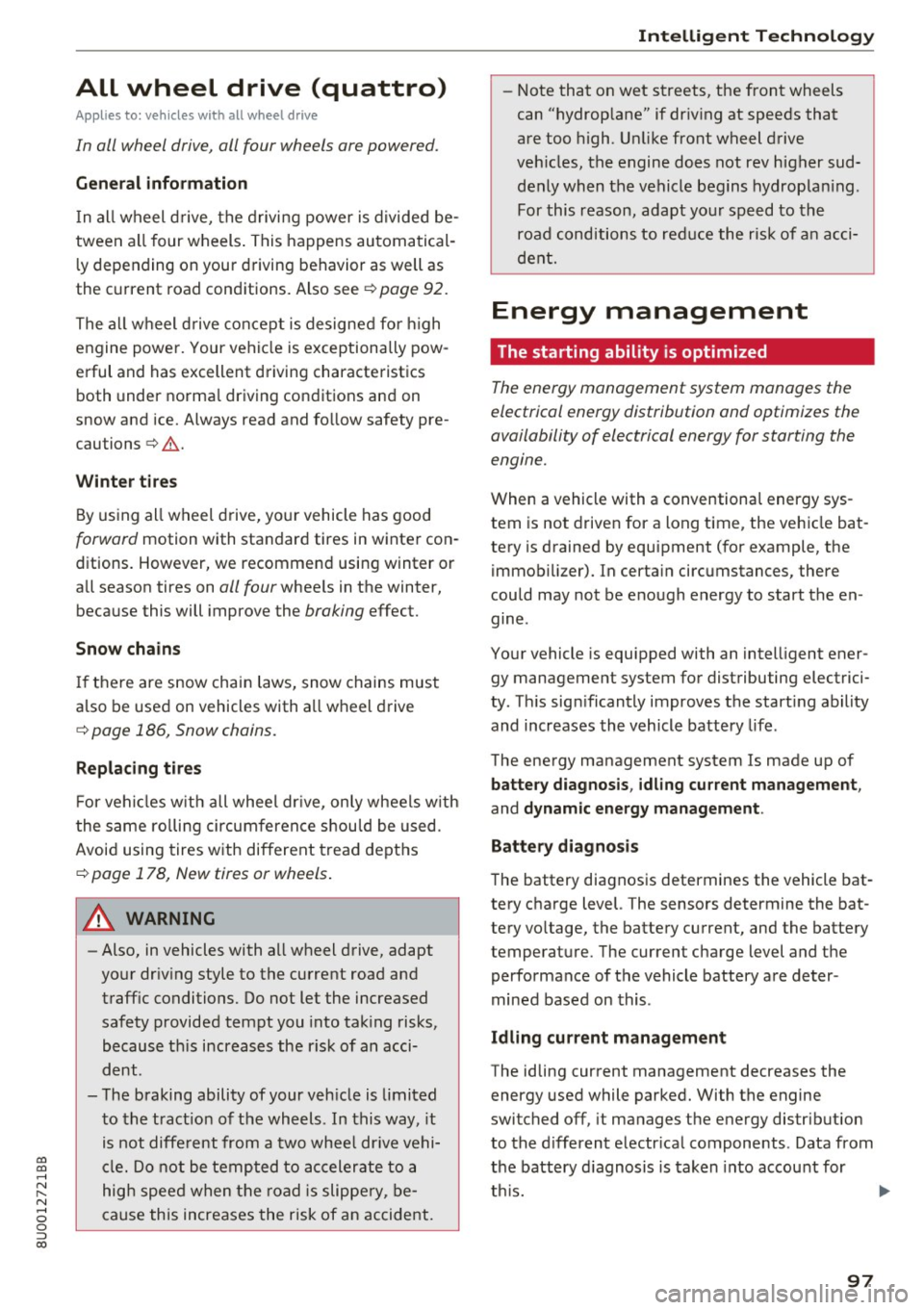
00
00
......
"' ,....
"' ...... 0 0 :::,
00
All wheel drive (quattro)
A ppl ies to: ve hicles wit h all wheel drive
In oil wheel drive, oil four wheels ore powered.
General info rmation
I n all wheel drive, t he driving power is divided be
tween all four wheels . This happens automatical
ly depending on your driving behavior as well as
the current road conditions. Also see
¢ page 92.
The a ll wheel d rive concept is designed for h igh
engine powe r. Your vehicle is exceptionally pow
erful and has excellent driving characteristics both under norma l driving conditions and on
snow and ice. Always read and fo llow safety pre
cautions ¢.&. .
Winter t ires
By using all wheel drive, yo ur vehicle has good
forward motion with standard tires in w inter con
ditions. However, we recommend using winter or
all season tires on
all four whee ls in the winter,
because this will improve the
broking effect.
Snow cha in s
If there are snow chain laws, snow chains must
a lso be used on vehicles with a ll wheel drive
¢ page 186, Snow chains.
Replacing t ires
F or vehicles w ith all wheel dr ive, only wheels w ith
the same ro lling circumference shou ld be used .
Avoid using tires with different tread depths
¢ page 178, New tires or wheels .
A WARNING
-Also, in vehicles with a ll wheel drive, adapt
your dr iv ing style to the current road and
traff ic conditions. Do not let the increased
safety provided tempt you into tak ing risks,
because th is increases the r is k of an acci
dent.
- The braking ability of your veh icle is limited
to the tract ion of the wheels . In this way, it
is not diffe rent from a two whee l dr ive vehi
cl e. Do not be tempted to accelerate to a
high speed when the road is slippe ry, be
cause this increases the risk of an accident .
Intellig ent Technology
- Note that on wet streets, the front wheels
can "hydrop lane" if dr iv ing at speeds that
are too high . Un like front wheel drive
veh icles, the engine does not rev higher sud
denly when the vehicle begins hydroplan ing .
For this reason, adapt yo ur speed to the
road conditions to red uce the risk of an acci
dent.
Energy management
The starting ability is optimized
The energy management system manages the
electrical energy distribution and optimizes the
availability of electrical energy for starting the
engine.
When a vehicle with a conventiona l energy sys
tem is not driven for a long time , the vehicle bat
tery is drained by equipment (for example, the
immobilizer). In certa in circumstances, there
could may not be enough energy to start the en
gine.
Yo ur vehicle is equipped with an intel ligent ener
gy management system for distributing electrici
ty . Th is sign ificantly improves the start ing ability
and increases the vehicle battery life .
The energy management system Is made up of
battery diagnosis , idling current manag em en t,
and dynamic energy manag ement .
Battery diagn osis
The battery diagnosis determines the vehicle bat
tery charge level. The sensors determine the bat
tery voltage, the battery current, and the battery
temperature. The current charge level and the
performance of the vehicle battery a re deter
mined based on this.
Idling current management
The idling current management decreases the energy used while parked. With the engine
switched off, it manages the energy dis tribution
to the d ifferent e lectr ica l components. Data from
the battery d iagnosis is taken into account for
t hi s.
97
Page 165 of 236

00
00
......
"' ,....
"' ...... 0 0 :::,
00
A udi rec ommend s
@;Cilstrot /Jgjgf ~ f'r,w.~7dr,,'1AJ.
A ud i re commends Longlife high p erform ance
e ngi ne oil from A udi Gen uin e P art s
Using the proper engine oil is important for the
functionality and service life of the engine. Your
engine was factory-filled with a high-quality oil
which can usually be used throughout the entire
year .
Note
Your Limited New Vehicle Warranty does not
cover damage or malfunctions due to failure
to follow recommended maintenance and use
requirements as set fo rth in the Aud i Owner's
Manual a nd Warranty & Mai ntenan ce booklet.
- Use only a high quality eng ine oil that ex-
pressly complies with the Aud i oil q ual ity
standard specified for your vehicle's engine. Using any other oil can cause serious engine
damage .
- Do not mix any l ubricants or othe r addi tives
into the engine oil. Doing so can cause en
gine damage.
(D Tips
If you need to add oil and there is none availa
ble that meets the Audi oil quality standard
your engine requires, you may add a total of
no more than 0 .5 quart/liter of a high-quality
"synthet ic"oil that meets the following speci
fications.
- ACEA A3 or API SM with a viscosity grade of
SAE OW-30, SAE SW-30 or SAE SW-40.
- For more information about engine oi l that
has been approved for your vehicle, please
contact e ither your authorized Audi dea ler
or Audi Customer Relat ions at
1 (800) 822-2834 or vis it our web site at
www.audiusa.com or www.aud icanada .ca.
Ch eck ing and Filling
Engine oil consumption
The engine in your vehicle depends on on ade
quate amount of oil to lubricate and
cool oil of
its moving ports.
In order to provide effect ive lubrication and cool
ing of internal engine components, all internal
combust ion eng ines consume a certa in amount
of oil. Oil consumption varies from eng ine to en
gine and may change s ign ificantly over the life of
the engine. Typ ica lly, engines w ith a specified
break-in period (see
q page 58) consume more
oi l during the break -in period than they consume
after oil consumption has stabilized.
Under normal cond itions, the rate of oil con
sumption depends on the q uality and viscosity o f
the oil, the RPM (revol utions per minute) at
which the engine is operated, the ambient tem perature and road condit ions. Further factors are
the amount of oil dilution from water condensa
tion or fuel residue and the oxidation level of the o il. As any engine is subject to wear as mileage
builds up, the oil consumption may increase over
time unt il replacement of worn components may
become necessary.
With all these variables coming into play, no standard rate of o il consumption can be estab
li shed or spec ified . T he re is no alte rnative to reg
u la r and frequent checking of the oi l level , see
Note .
If the yellow engine o il leve l warning symbo l !I
in the instrument cluster lights up, you sho uld
check the o il level as soon as possible
q page 164. Top off the o il at your earlies t con
venience.
A WARNING ~
Before you check anything in the engine com-
partment, always read and heed all WARN
INGS
q .&. in Working in the engine comport
ment on page 159.
(D Note
Driving with an insufficient oil level is likely to
cause severe damage to the eng ine. ..,.
163
Page 166 of 236

Checking and Filling
@ Tips
-The oil pressure warning display. is not
an indicator of the oil level. Do not rely on
i t. Instead , check the oil level in your en
gine at regular intervals, preferably each
time you refuel, and always before going
on a long trip.
- If you have the impression your engine con
sumes excessive amounts of oil, we recom
mend that you cons ult an autho rized Aud i
dealer to have the cause of your concern
properly diagnosed. Keep in mind that the
accurate measurement of oil consumption
requires great care and may take some
time. An authorized Audi dealer has instruc
tions about how to measure oil consump
tion accurately .
Checking the engine oil level and adding
engine oil
Fig. 141 Oil d ipst ick: check ing engine o il level
Fig. 142 Engine co mpa rtment : en gin e oi l fille r opening
cove r
Obse rve the safety p recau tions c:::> & in Working
in the engine comportment on page 159.
Checking the engine oil level
-Park the vehicle on a level surface.
164
- Shut the engine off when it is warm . Wait ap
proximate ly two minutes so that the engine oil
can flow back into the oil pan.
- Open the hood c:::>
page 161.
-Remove the oil d ipstick c:::> page 162, fig . 140,
w ipe it off with a clean cloth and inse rt it all the
way in again.
- Remove the oil dipstick again and then read the
oil level c:::>
table on page 164.
-Add engine o il if necessary.
Area on oil dipstick
c:::> fig. 141.
@ If
the engine oil leve l is just before the
mark ing@ , then engine oil must be added.
See
c:::> (D.
@ Do not add engine o
il.
Adding engine oil
- Unscrew the cap "t!:;f; c:::> fig. 142 for the engine
oil f illing opening c:::>
page 162, fig . 140.
- Carefully add 0.5 quart (0.5 liter) of the correct
oil c:::>
page 162.
-Check the oil level again after two minutes.
- Add a smaller amount of engine oil if necessa-
ry . The mark ing@c:::>fig .
141 must not be ex
ceeded c:::>
(D.
-Sc rew the engine oil filler cap "t!:;f; and slide the
dipstick all the way in.
A WARNING
- When adding engine oil, do not let oil drip
onto hot engine components. This increases
the risk of a fire.
- You must seal the cap on the oil filler open
ing correctly so that oil does not leak out
onto the hot engine and exhaust system
when the engine is running, because this is
a fire hazard.
-A lways clean sk in thoroughly if it comes into
contact with engine oil.
(D Note
-The engine oil level must not be under the
marking @, because this increases the risk
of engine damage .
- After adding engine oil, the oil leve l must
not be above the mark ing@ , because this
Page 167 of 236
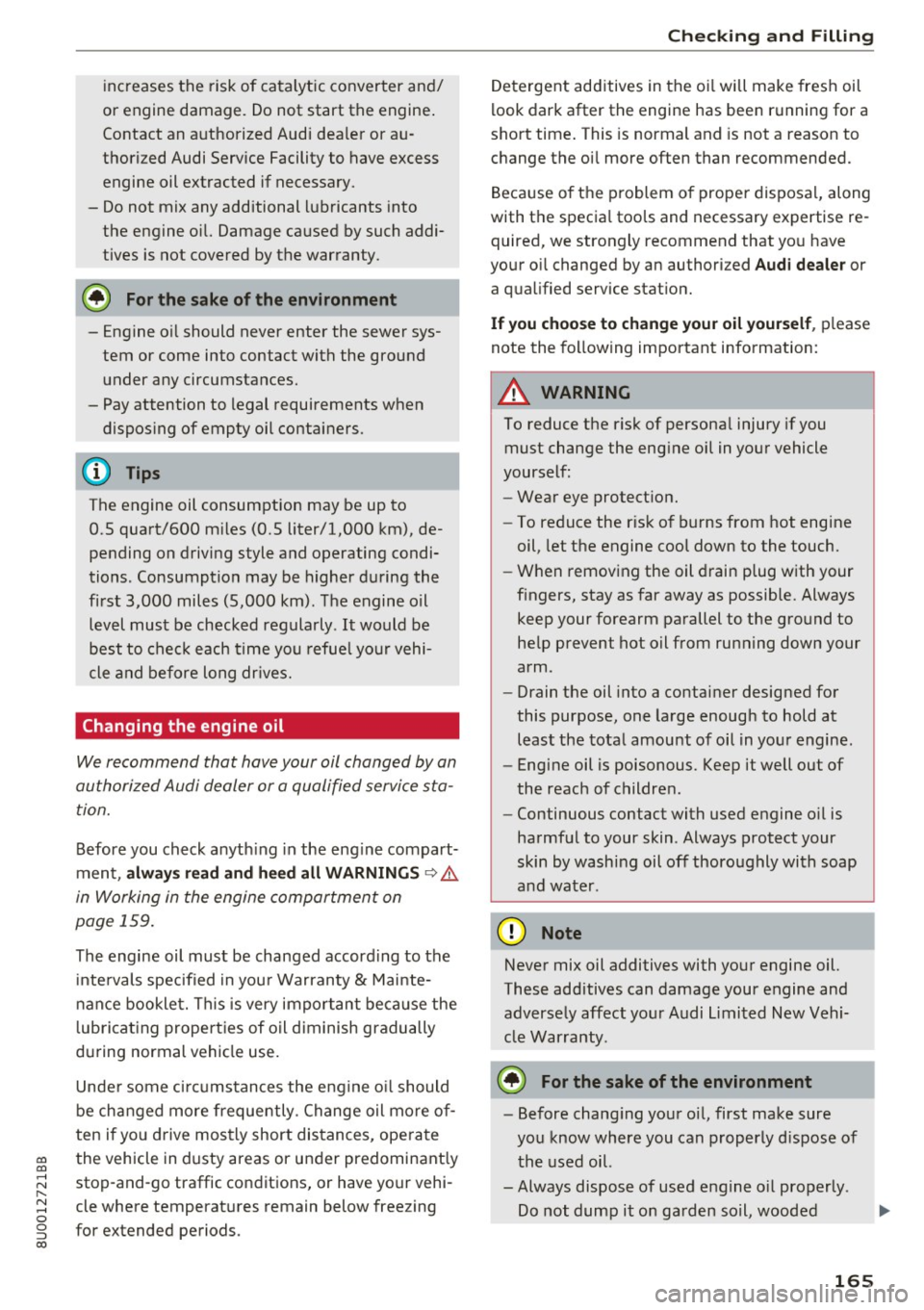
00
00
......
"' ,....
"' ...... 0 0 :::,
00
increases the risk of catalytic converter and/
or engine damage. Do not start the engine. Contact an authorized Audi dealer or au
thorized Audi Service Facility to have excess
engine oil extracted if necessary.
- Do not mix any additional lubricants into
the engine o il. Damage caused by such addi
tives is not covered by the warranty.
@ For the sake of the environment
-Engine o il should never enter the sewer sys
tem or come into contact with the ground under any circumstances.
- Pay attention to legal requirements when
dispos ing of empty oil containers.
@ Tips
The engine oil consumption may be up to
0.5 quart/600 m iles (0.5 liter/1,000 km), de
pending on driving style and operating condi
tions. Consumption may be higher during the
fi rst 3,000 miles (5,000 km). The engine o il
level must be checked regularly.
It would be
best to che ck each t ime you refue l yo ur vehi
cle and before long dr ives.
Changing the engine oil
We recommend that have your oil changed by an
authorized Audi dealer or a qualified service sta tion.
B efore you check a nyth ing in the eng ine compart
ment,
alw ay s read and heed all WARNINGS ~ .&.
in Working in the engine compartment on
page 159.
The engine oil must be changed according to the
inte rvals spec ified in you r Warranty
& Mainte
nance booklet. This is very important because the
l ubri cat ing propert ies of o il diminish gradually
d uring normal vehicle use.
Unde r some ci rcumstances the eng ine o il should
be changed more frequently. Change oil mo re of
ten if yo u drive mos tly short distances, ope rate
the vehicle in dusty areas or under predominant ly
stop -and -go traffic condit ions, or have your vehi
cle where temperat ures remain below freezing
for extended periods.
Ch eck ing and Filling
Detergent add itives in the oi l will make fresh oil
l ook dark after the engine has been running for a
short time . This is normal and is not a reason to
change the oi l more often than recommended.
Beca use of the problem o f proper disposal, along
with the specia l too ls and necessary expertise re
quired, we strongly recommend that yo u have
your o il changed by an authorized
Audi dealer or
a qual ified service stat ion.
If you choo se to change you r oil yourself , please
note the following important info rmation:
A WARNING "--
To reduce the risk of persona l injury if you
must change the eng ine oil in your vehicle
yourself:
- Wear eye protect ion.
-
- To reduce the r is k of burns from hot engine
oil, let the engine coo l down to the touch.
- When remov ing the oil drain plug w ith your
f ingers, stay as far away as possib le. Always
keep your forearm parallel to the gro und to
he lp prevent hot oil from running down your
arm.
- Drain the oil into a container designed for
this purpose, one large enough to hold at least the tota l amou nt of oil in you r engine.
- Engine oil is poisonous. Keep it well out of
the reach of childre n.
- Continuous contact with used engine o il is
harmf ul to your skin. Always protect your
skin by wash ing oil off thoroughly with soap
and wate r.
«I) Note
Neve r mix oil additives with your engine oil.
These additives can damage your engine and
adverse ly affect yo ur Audi limited New Vehi
cle War ranty.
@ For the sake of the environment
- Before chang ing yo ur oi l, first make sure
you know where you can properly d ispose of
the used oil.
- Always dispose of used engine o il properly .
Do not dump it on ga rden soil, wooded
165
Page 168 of 236
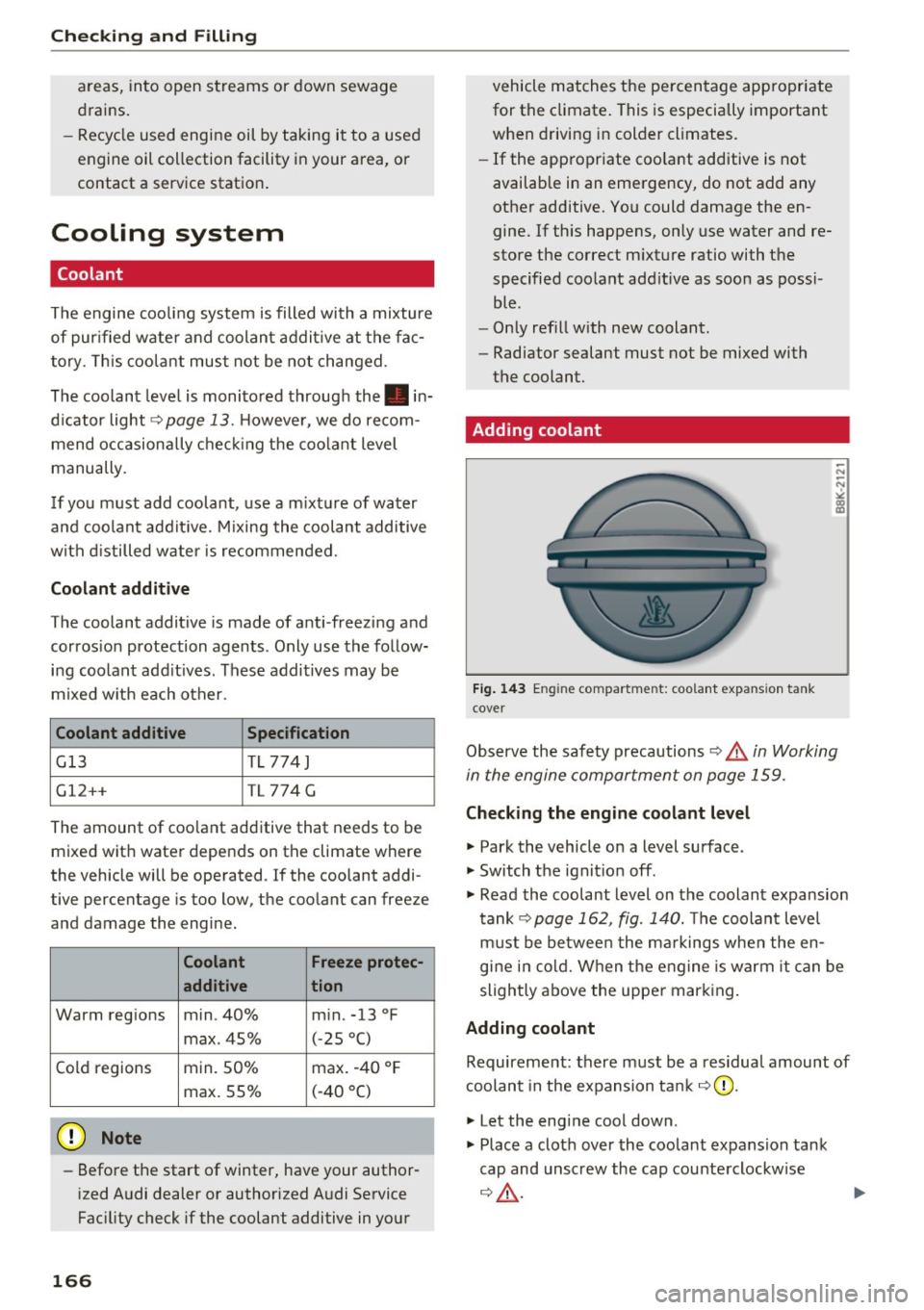
Check ing and F illing
areas, into open streams or down sewage
drains .
- Recycle used engine oil by taking it to a used
engine oil collection facility in your area, or
contact a service station .
Cooling system
Coolant
The engine coo ling system is filled wi th a mixture
of pur ified w ate r a nd coolan t addit ive at the fa c
tory . T h is coo lant must not be not changed.
The coolant leve l is monito red throug h the . in
d icator light~
page 13 . Howeve r, we do re com
mend occasionally check ing the coo la nt level
manually.
I f you must add coolant, use a m ixt ur e of wa ter
and coolant addit ive. M ixing the coolant additive
with d istilled wate r is recommen ded .
Coolant additive
The coolant additive is made of a nti-freezi ng a nd
corros ion protection agents . Only use the fo llow
i n g coolant add it ives. These additives may be
mixed w it h each other.
Coolant additive Specification
G13 TL774J
G12++ T
L 774 G
The amount of coo lant additive that needs to be
mixed wit h wate r depends on the climate where
the vehicle will be operated . If the coolant addi
tive percentage is too low, the coolant can freeze
and damage the engine.
Coolant Freeze protec-
additive tion
Warm reg ions min . 40% m in . -13 °F
max . 45% (
- 25
°()
Co ld regions min. 50% max
. -40 °F
max. 55% (-40 °()
0 Note
- Befo re the start of winter, have your author
i zed Audi dealer or authorized A udi Service
Fac ility check if the coolant additive in you r
166
vehicle matches t he percentage app ropriate
for the climate . This is especially important
when driving in colder climates.
- If the app ropriate coo lant additive is not
available in an eme rgency, do not add any
other additive. You could damage the en
gine. If this happens, only use water and re
store the correct m ixture ratio with t he
specified coo lant add itive as soo n as poss i
bl e.
- Only ref ill w ith new coolant.
- Radiator sealant must not be mixed with
the coolant.
· Adding coolant
Fi g. 14 3 En gin e compartment: coo lant expa nsio n ta nk
cove r
Observe the safety precautions ~.& in Working
in the engine compartment on page 159 .
Checking the engine coolant level
.. Park the vehicle on a level surface .
.. Switch the ignit io n off.
.. Read the coolant level on the coolant expansion
t ank ~
page 162, fig. 140. The coolant leve l
m ust be be twee n the m arkings when the en
gi ne i n co ld. W hen t he engine is warm it can be
slightly above the upper mar king.
Adding coolant Requirement: there must be a residua l amount of
coolan t in the expansion tank ~(}).
.,. Let the engi ne cool down .
.. Place a clot h over the coolant expans ion tank
cap and unscrew the cap counte rclockw ise
~ .& -